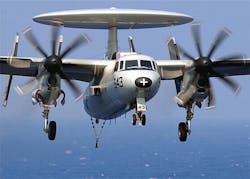Pentagon's proposed 2016 budget would increase military spending by $38.2 billion next year
The proposed U.S. Department of Defense (DOD) base budget for 2016 calls for spending $534.3 billion, up 7.7 percent over this year's enacted DOD budget of $496.1 billion, according to Pentagon budget documents. Federal fiscal year 2016 begins next October.
The proposed Pentagon budget for next year, released Monday, includes $50.9 billion for overseas contingency operations -- a $13.3 percent from current levels -- to pay for military operations in Iraq, Afghanistan, and other areas that involve the global war on terrorism. Now the DOD budget goes to Congress for consideration.
The 21-percent reduction in overseas contingency operations reflects "the end of the combat mission and the continued drawdown of forces in Afghanistan," DOD officials say. The budget includes $7.8 billion to repair and upgrade equipment used in military actions.
The proposed 2016 DOD budget would pay for overall U.S. military goals that include a pivot to the Asia-Pacific region, commitment to security and stability in Europe and the Middle East, countering violent extremists, investments in technology, and strengthening alliances and partnerships around the world, DOD officials say.
Related: First look: fiscal 2015 DOD budget hits procurement and research hard
Important components in the 2016 DOD budget proposal are modernizing the nation's nuclear weapons arsenal, space, missile defense, cyber security, and power projection. The budget moves away from sequestration-level military funding, which "would be irresponsible and dangerous, resulting in a force too small and ill equipped to respond to the full range of potential threats to the nation," according to a DOD statement.
The budget calls for funding for an alternative domestic space launch capability, and for advanced sensors, communications, and munitions, DOD officials say.
The budget asks Congress for $10.6 billion to buy 57 Lockheed Martin joint strike fighters; $3.4 billion for 16 Boeing P-8 maritime patrol jet aircraft; $1.3 billion for five E-2D carrier-based radar surveillance aircraft; $3 billion to develop the KC-46 airborne tanker; and $1.2 million for research in developing a new-generation long-range jet bomber.
The budget asks for $11.6 billion for nine new U.S. Navy surface ships; $678 million to overhaul the nuclear-powered aircraft carrier USS George Washington (CVN 73); $1.4 billion to develop a new-generation nuclear-powered ballistic missile submarine to replace the nation's Ohio-class missile submarines; and $55 million to support the Navy's littoral combat ship.
Related: Military spending for electronics and communications stable after steep decline
Other proposed initiatives include $5.5 billion for cyber security; $1.6 billion for missile defense ground based interceptor reliability; $4.5 billion for U.S. Army combat helicopter modernization; and $821 million for additional MQ-9 Reaper attack drones.
Other areas of the proposed 2016 DOD budget contain funding for high-speed strike weapons; railgun development; positioning, navigation, and timing; and high-energy laser weapons.
The budget also calls for a reduction of 11,300 in active-duty military personnel to an active-duty strength of 1.3 million soldiers, sailors, airmen, and Marines. The budget would fund 49 tactical fighter squadrons, 54 Army brigade combat teams, 14 ballistic missile submarines, 450 nuclear-tipped intercontinental ballistic missiles; 96 jet bombers; and 304 Navy ships, including 11 aircraft carriers.
The Pentagon's 2016 budget request calls for $126.5 billion for the Army; $161.0 billion for the Navy and Marine Corps; and $152.9 billion for the Air Force. A proposed $94 billion for defense-wide activities would fund special operations, military intelligence, missile defense, and military research.
